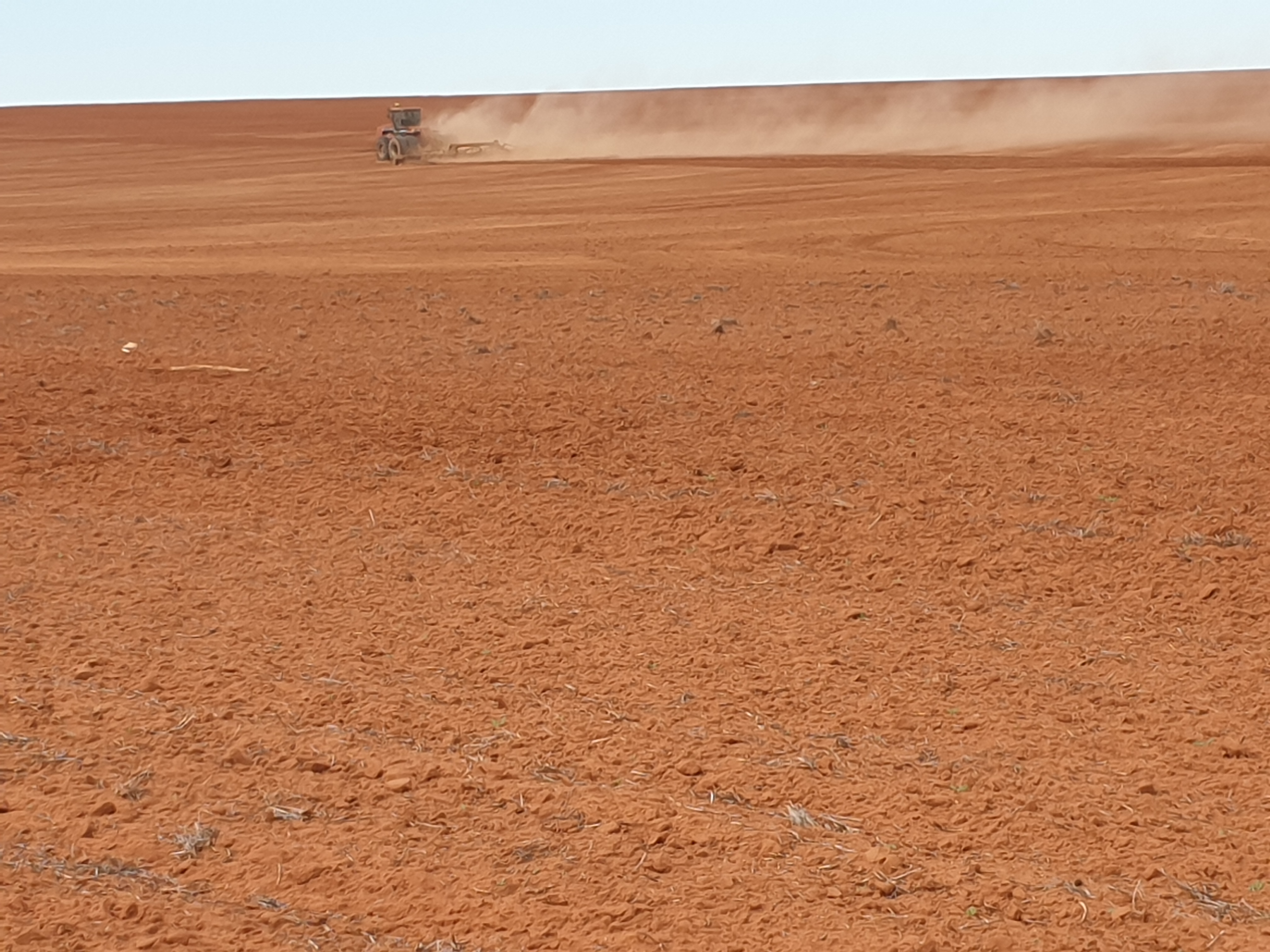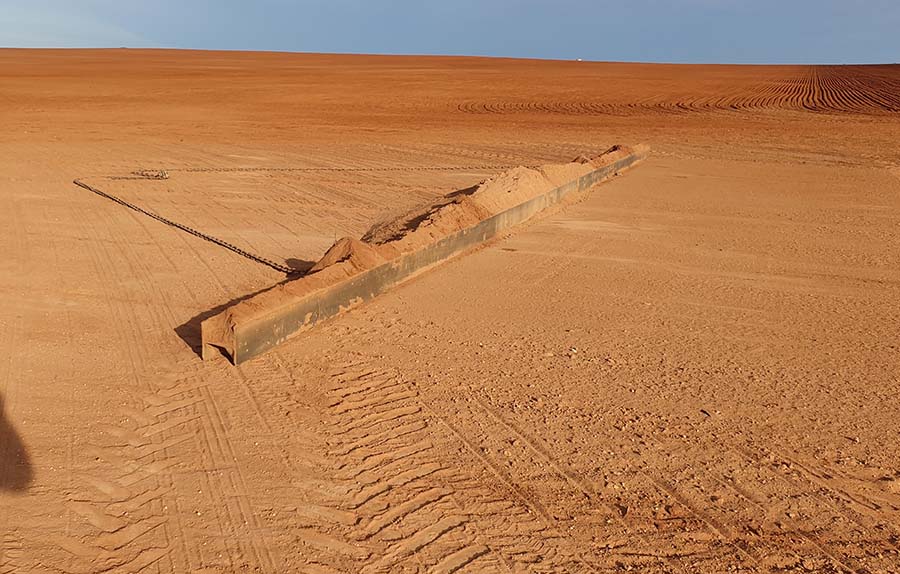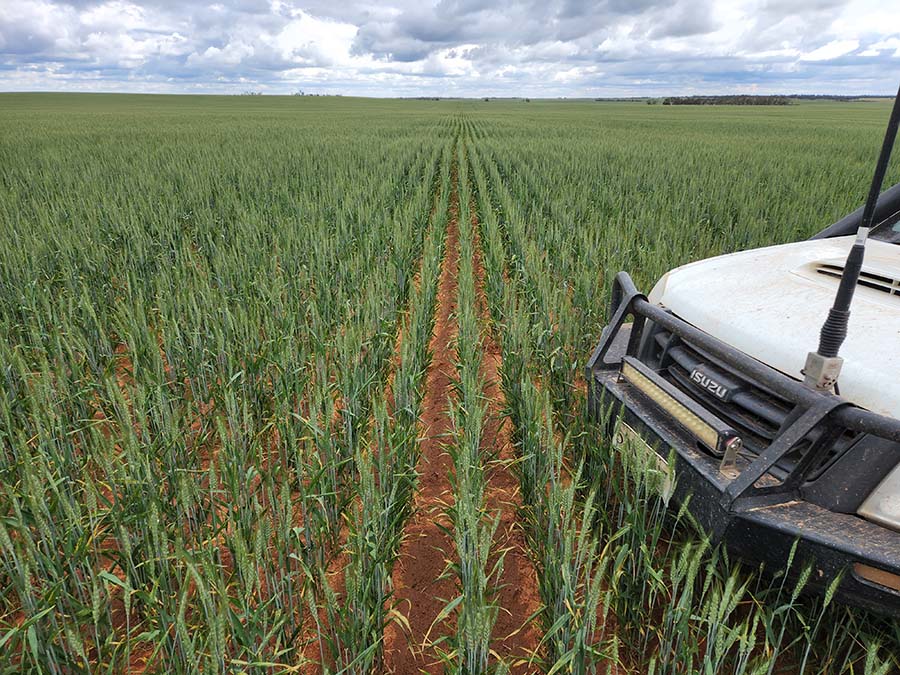Snapshot
Grower: Nigel Baird
Location: Wentworth, NSW Mallee
Farm size: 2,000 Ha cropping land; 45,00 Ha sheep station
Enterprise: Continuous cropping and grazing
Growing season rainfall: 200mm annual (120mm GSR) - Wentworth
Soil type: Deep sands to good fertile loams over clays, intersperesd with poor producing marly loams
Cropping program: 75% cereal and 25% pulses
Seeding system: No-till farming, Seed Hawk Air Drill, deep knife points and sectional control, and variable rate capacity.
Nigel Baird runs a 45000ha sheep station 60km north of Wentworth at Anabranch South, with 2000ha of cropping land. Annual rainfall is 200mm, with only 120mm on average falling in the growing season. The Baird’s soils range from deep sands to good fertile loams over clays, interspersed with poor producing marly loams. Given the nature of his farming operation, soil erosion is a significant concern, particularly in successive years of drought.
The challenge
Several factors increase the risk and impact of erosion across the NSW Mallee, even for those using sustainable farming practices:
- Very low and highly variable rainfall (200-260mm average annual rainfall and 120-160mm average growing season rainfall).
- Variable and highly erodible soils, including sands and poor marly clay loam soils.
- Large cropping/grazing areas with few fences amid vast station grazing country.
- Large river systems channelling huge wildlife (and vermin) into the area through drought periods.
Following the NSW Mallee’s severe 2018 and 2019 drought, issues were created beyond Nigel’s control. The significant erosion damage from the invasion of kangaroos, emus and goats; coupled with existing erosion issues resulted in the removal of the most fertile proportion of the soil. This combination of events highlighted the need to repair paddocks when suitable opportunities were presented.
The worst drought experienced in a lifetime
Growing wildlife numbers on the move as drought loomed in 2017
In 2017, Nigel received just enough summer rain, subsoil moisture and opening rainfall to crop with confidence. However, this was followed by long dry periods, during both winter and spring, that greatly diminished crop production and feed availability (GSR 60mm). The dry conditions saw kangaroos, emus, and goats devour, disrupt, and bare out crop residues and pasture ground cover over the summer leading into 2018.
A late break and a dry season
Strong winds started in May 2018 and seeding rains did not arrive until late June. The limited 2017 stubbles dislodged, balled up, and along with other summer weeds, created lumpy, uneven and unprotected paddocks. Nigel sowed some areas to try and establish cover on bare ground, while many others in the district chose not to sow. Strong winds again followed, causing massive soil loss and damage, particularly in areas where animal traffic was highest.
The killer second year of drought
Late rain events in 2018 provided stored moisture for some, giving hope of recovery. However, the second year of drought in 2019 set in with only 60-90mm rainfall across the district, resulting in further ground cover loss. While 2020 provided some relief, and some crop cover was achieved, major soil renovation and leveling was required following the destructive impacts of the previous seasons in order to be able to seed and harvest future crops.
Know what you can and can’t control when it comes to protecting soils
What can’t be controlled
Farming in this region means that, at times, a combination of circumstances will present challenges you can’t protect against, including:
- Seasonal factors – extended periods of low rainfall, heat and strong winds over successive years,
- Significant wildlife and vermin grazing - and trafficking pressures in extreme situations surging into the farming areas from station country and being corralled into these farms by the major river systems.
What can be controlled
While challenges will always arise, there are key decisions relating to ground cover maintenance. These can protect soils and improve aggregate stability and include:
- Paddock and rotational choices – Managing effective cropping, pastures and grazing rotations
- Farming system management - Tillage practices, implement decisions and agronomic practices,
- Grazing strategies - Stock numbers, grazing pressures and residue retention decisions,
- Decision making - Planning and monitoring, with strategic and flexible management options on-hand.
Weighing up the right time to rehabilitate after drought
Uneven eroded paddocks must be levelled bare to crop again, but only when soil moisture allows for immediate cereal crop growth.
It can pay to delay!
Multiple passes with Nigel’s chisel plough, prickle chain and levelling bar were seen as the best solution to fixing uneven and lumpy paddocks in preparation for cropping. The risk of creating a greater erosion hazard by fining up the marly loams and the fragile sands was always front of mind. For Nigel, it meant it could only be done in a season with adequate subsoil moisture and good pre-seeding rains.
In 2021, ideal conditions did not eventuate (Photo 1), so Nigel decided to delay rehabilitation for another year. While this resulted in an increase in paddock lumpiness and the soil blew, lodging around volunteer growth and residues, it was a far safer option than exposing the whole paddock and failing to achieve any crop cover. Nigel has found that it is still important to control summer weeds even when soil cover levels are poor; otherwise, the patchy weed growth and residues create even more havens for the soil to mound around.
Deep furrow ripping to assist catching and holding shifting soils
When the decision is made to hold off rehabilitating for future seasons, deep furrow rip-lines in heavier soil types can be useful as an interim measure to reduce erosion. This roughens the surface to produce clayey clods, which catch and hold shifting soil—a worthwhile option for seasons too risky for attempting levelling and reseeding.
More information: Agriculture Notes: Wind erosion control PDF; Rural Solutions SA PIRSA: Emergency measures to curb wind erosion factsheet.
The 2022 opportunity
In late April, critical rains arrived and gave Nigel the confidence to level his eroded cropping paddock.
Nigel commented, “In these situations, you are 100% committed. As soon as you work the ground the first time, it’s all or nothing. There is no turning back.”

Sandy and marly loam soils required levelling to take out all lumpy ground after years of drought. Photo: Supplied.
The paddock required many passes with a chisel plough with deep penetrating sweeps and looped prickle chain behind. Then multiple levelling passes followed with a steel H beam to move the dirt around (Photo 3). In hindsight, Nigel indicated it may have been easier with a scraper or laser leveller, but he got by with what he had. While all this soil disturbance goes against achieving the desired benefits within no-till farming systems, Nigel considered this necessary to attain the best long-term paddock outcomes.
Sowing commenced as the final levelling passes were completed. Nigel cross-sowed wheat on the most vulnerable crop areas to help maximise establishment where it was most needed, along with applying higher fertiliser rates.

Iron bar used to level paddock prior to sowing. Photo: Supplied.
The crop established well in 2022 with minimal wind damage, and there are no plans to graze over summer. He hopes he won’t be faced with a similar situation in the future so that his normal minimal paddock grazing strategies and no-till farming system will be able to maintain enough cover to protect his soil.
Key lessons - cropping paddock management after drought
Reflecting on the 2018-19 drought, Nigel identified several areas which are key to reducing erosion and supporting long-term system productivity
- Pay attention to early warning signs – If paddocks have less than 50% cover during the previous September, they are at high risk of baring out and blowing if the following season is poor. Always monitor soil moisture conditions to support the best crop type, timing and rotational decisions.
- Crop and variety choices – There are many options available, and it’s about knowing what each can offer, such as plant type for early vigour and broader weed control system (example - Clearfield®) benefits.
- No-till cropping systems are paramount – Sowing and creating press-wheel furrows greatly assist water harvesting for crops. They also provide wind protection for seedlings.
- Strategic pulse use within the rotation – To ensure continued long-term soil protection, it is best to sow pulses into strong standing stubbles with 50% ground cover and only graze lightly after harvest.
- Monitor wildlife levels – If wildlife and vermin populations and damage appear to be building up, then lower risk management strategies may need to be implemented, such as not sowing pulse crops, only sowing cereals if moisture benchmarks have been well met, and/or earlier removal of livestock from stubble paddocks.
- Light stubble grazing – Monitor the weakest paddock areas and know when to remove stock. Ensure a high level of standing stubble is maintained, as once it is flattened by grazing, wind can move it around and cause problems. When stock roam into saltbush areas, it’s a good indication grazing value is limited.
- Don’t graze during a drought – Don’t graze cropping stubbles through drought years, as maintaining soil cover is paramount.

Chisel plough with looped prickle chain. Photo: Supplied.

Restored paddock in Sept 2022. Photo: Supplied.
Read: Rules of thumb for optimal cropping paddock management.
Listen to the podcast: NSW strategies and paddock restoration experience after drought.

























































